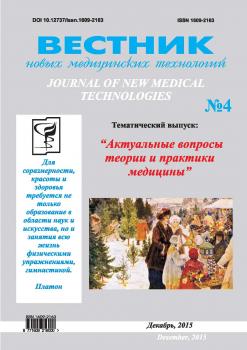from 04.07.2013 until now
This paper presents the main concept of our studies performed in 2011 on the structural and functional changes monitoring in single muscle fibers on a chip, allowing multivariate measurements. We propose here the synchronization of the following analytical techniques: micromechanical measurements performed using a grammometer-type dynamometric / tensometric system with digital recording; real-time on-chip morphometric microscopy; X-ray tissue analysis with the discrete identification ("barcoding") of the structural data from the matrix registration array detector; stimulation electromyography at various excitation parameters using the chip providing the response spectra of the sample at each excitation signal type. The graphical representation of the above measurements correlation provides useful information on the relationship between the structure and function of the sample at both cytophysiological and su-pramolecular levels and can be compared with the database. Correlation analysis of the biochemical response of the isolated muscle fiber to either electrophysical or electrochemical stimulation allows to detect teinochemical effects resulting from the conformational changes both at macromolecular and supramolecular scale, since the deformation value and, hence, the fiber contraction, depends on the variable medium characteristics or the external effect parameters and can be corresponded to them in a special database. Furthermore, the technique proposed allows a direct on-chip study of the effects of pharmacological and physiotherapeutic agents causing similar conformational changes in situ. The using of X-ray methods of colloid and tissue analysis provides identification of the results of the following processes: dehydration, thermal effects, electrophysiological excitation and chloroform-caused anesthesia. The design of organ-specific or tissue-specific descriptors depending on the fiber orientation would allow to distinguish between the various muscle fiber types and sources within the basis of comparative histological interpretation.
lab on a chip, grammometer, dynamometer, isolated muscle fiber, X-ray analysis, MEMS, electromyo-graphy.
Введение. Данная статья представляет концепт незавершенной в силу нехватки средств работы 2011 года, продолженной в недавнем времени благодаря содействию наших коллег из Норвегии (ЕС) и Зеленограда, посвященной методам наблюдения структурно-функциональных изменений в одиночных мышечных структурах на чипе, допускающем проведение подобных многофакторных измерений. В настоящей работе нами предлагается синхронизировать: микромеханические измерения, выполняемые с помощью динамометрической / тензометрической системы граммометрического типа с цифровой регистрацией; микроскопию с морфометрией на чипе в режиме реального времени; рентгенографию ткани с идентификацией («баркодингом») рентгенострук-турных данных с матричной регистрирующей платформы; стимуляционную электромиографию на разных параметрах возбуждения через чип с получением спектров отклика образца в каждом конкретном типе сигнала возбуждения. Графики корреляции данных измерений представляют собой эвристически ценные взаимосвязи структуры и функции объекта на цитофизиологическом и супрамолеку-лярном уровнях и масштабах организации.
Так, например, морфометрия уединенного препарата при известном сигнале стимуляции, задаваемом с помощью графического интерфейса (GUI) на аналоговом цифровом преобразователе (АЦП) при инициализации эксперимента, дает возможность судить об эффективности трансдукции сигнала и рефлекторной деятельности, а также хронаксии в том смысле, в котором это допустимо при миологическом анализе на уединенном микропрепарате. Это обусловливаемо пространственно-временным характером проведения и, как следствие, прямо измеряемой по морфометрическим характеристикам парамет-рикой импульса, включая времена и скорости затухания. Если говорить о динамометрической характеристике, соответствующей процессам сокращения, то для её анализа в случае исследования на изолированных препаратах рационально применять микроэлектромеханические системы (MEMS), легко встраи-






